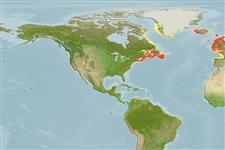Onoba aculeus (Gould, 1841)
Pointed cingula| Native range | All suitable habitat | Point map | Year 2050 |

|
| This map was computer-generated and has not yet been reviewed. |
| Onoba aculeus AquaMaps Data sources: GBIF OBIS |
Upload your photos
Google image |
No photo available for this species.No drawings available for Rissoidae.
Google image |
No photo available for this species.
Classification / Names Common names | Synonyms | CoL | ITIS | WoRMS
| Littorinimorpha | Rissoidae
Environment: milieu / climate zone / depth range / distribution range Ecología
; rango de profundidad 0 - 115 m (Ref. 83435). Temperate; 82°N - 30°N, 77°W - 61°E
Distribución Países | Áreas FAO | Ecosistemas | Ocurrencias, apariciones | Introducciones
Northeast Atlantic, Arctic and the Mediterranean: North America. Temperate to polar.
Length at first maturity / Tamaño / Peso / Age
Maturity: Lm ? range ? - ? cm Max length : 0.4 cm DL macho / no sexado; (Ref. 83435)
Known to occur on bathyal, infralittoral and circalittoral of the Gulf and estuary. Generally for group, planktonic and minute detrital food items through either suspension or deposit feeding (Ref. 87872).
Life cycle and mating behavior Madurez | Reproducción | Puesta | Huevos | Fecundidad | Larva
Sexes are separate but are seldom conspicuously different externally, simultaneous hermaphrodites yet self-fertilization is prevented due to various morphological, physiological, or behavioral mechanisms; generally, marine gastropods shed their eggs (Ref. 87872).
Main reference
Referencias | Coordinador | Colaboradores
Harms, J. 1993. (Ref. 2711)
IUCN Red List Status (Ref. 130435)
CITES status (Ref. 108899)
Not Evaluated
CMS (Ref. 116361)
Not Evaluated
Threat to humans
Human uses
| FishSource |
Herramientas
Más información
Países
Áreas FAO
Ecosistemas
Ocurrencias, apariciones
Introducciones
Stocks
Ecología
Dieta
componentes alimenticios
Áreas FAO
Ecosistemas
Ocurrencias, apariciones
Introducciones
Stocks
Ecología
Dieta
componentes alimenticios
Age/Size
Crecimiento
Length-weight
Length-length
Morfología
Larva
Abundancia
Crecimiento
Length-weight
Length-length
Morfología
Larva
Abundancia
Fuentes de Internet
BHL | BOLD Systems | CISTI | DiscoverLife | FAO(Publication : search) | Fishipedia | GenBank (genome, nucleotide) | GloBI | Gomexsi | Google Books | Google Scholar | Google | PubMed | Árbol de la vida | Wikipedia (Go, búsqueda) | Expediente Zoológico
Estimates based on models
Preferred temperature
(Ref. 115969): 7.1 - 12.5, mean 10.7 (based on 304 cells).
Price category
(Ref. 80766):
Unknown.


